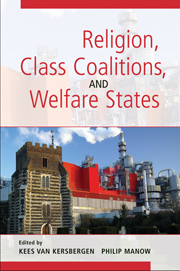Book contents
- Frontmatter
- Contents
- Preface
- List of Contributors
- 1 Religion and the Western Welfare State – The Theoretical Context
- 2 Western European Party Systems and the Religious Cleavage
- 3 The Religious Foundations of Work-Family Policies in Western Europe
- 4 Italy: A Christian Democratic or Clientelist Welfare State?
- 5 Religion and the Welfare State in the Netherlands
- 6 A Conservative Welfare State Regime without Christian Democracy? The French État-Providence, 1880–1960
- 7 Religion and the Consolidation of the Swiss Welfare State, 1848–1945
- 8 The Church as Nation? The Role of Religion in the Development of the Swedish Welfare State
- 9 The Religious Factor in U.S. Welfare State Politics
- 10 Religious Doctrines and Poor Relief: A Different Causal Pathway
- Index
8 - The Church as Nation? The Role of Religion in the Development of the Swedish Welfare State
Published online by Cambridge University Press: 28 January 2010
- Frontmatter
- Contents
- Preface
- List of Contributors
- 1 Religion and the Western Welfare State – The Theoretical Context
- 2 Western European Party Systems and the Religious Cleavage
- 3 The Religious Foundations of Work-Family Policies in Western Europe
- 4 Italy: A Christian Democratic or Clientelist Welfare State?
- 5 Religion and the Welfare State in the Netherlands
- 6 A Conservative Welfare State Regime without Christian Democracy? The French État-Providence, 1880–1960
- 7 Religion and the Consolidation of the Swiss Welfare State, 1848–1945
- 8 The Church as Nation? The Role of Religion in the Development of the Swedish Welfare State
- 9 The Religious Factor in U.S. Welfare State Politics
- 10 Religious Doctrines and Poor Relief: A Different Causal Pathway
- Index
Summary
INTRODUCTION
Religion as an explanatory variable is conspicuously absent in most accounts of the historical development of the Scandinavian welfare states. Most explanations of the emergence of a ‘Social Democratic’ welfare regime in Scandinavia emphasize the power resources of class actors, especially the labor movement (Korpi 1978; Stephens 1979; Esping-Andersen 1985), the influence of cross-class coalitions (Swenson 2002), or the impact of policy legacies and autonomous state actors (Heclo 1974; Weir and Skocpol 1985). A survey of the large literature on the formative period of the Swedish welfare state reveals few references to the role of religion or the Church of Sweden, and the same is true of the period after 1932, when the Social Democratic Party (SAP) was arguably the single most important actor in Swedish social policy development.
The classic analyses of the development of party systems in Western Europe attribute the weakness of religious parties in Scandinavia to the absence of a religious cleavage (Lipset and Rokkan 1967; cf. Kaspersen and Lindvall 2008). As Manow and van Kersbergen discuss in the introduction to this volume, proportional representation combined with Scandinavian cleavage structure led to the emergence of a party system with plenty of space for various socioeconomic interests, such as agrarian parties, where as religious parties were weak or nonexistent.
The Scandinavian pattern of church–state relations was established during the 1500s. In the wake of the Reformation, Danish and Swedish monarchs usurped church influence and wealth, incorporated the clergy into the state apparatus, and assumed the welfare functions that the church had previously performed, such as hospital care and poor relief.
- Type
- Chapter
- Information
- Religion, Class Coalitions, and Welfare States , pp. 210 - 235Publisher: Cambridge University PressPrint publication year: 2009
- 18
- Cited by



